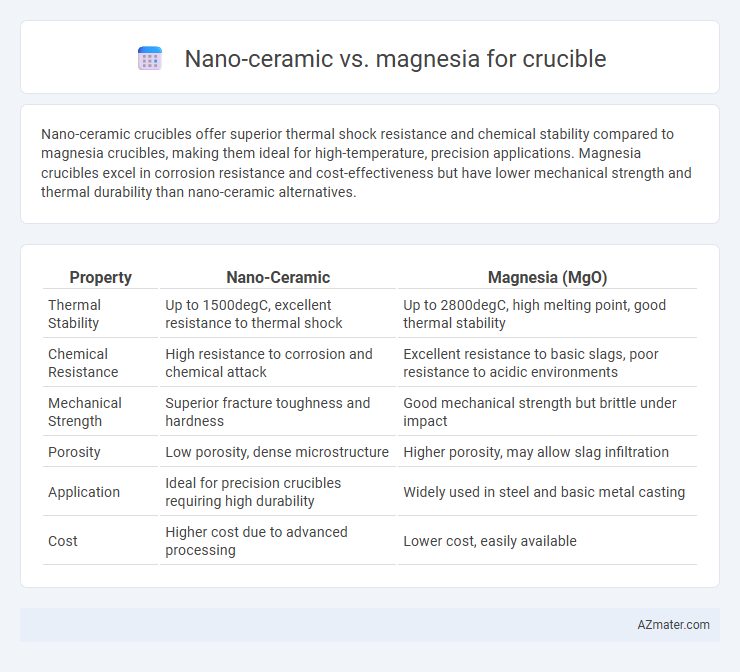Nano-ceramic crucibles offer superior thermal shock resistance and chemical stability compared to magnesia crucibles, making them ideal for high-temperature, precision applications. Magnesia crucibles excel in corrosion resistance and cost-effectiveness but have lower mechanical strength and thermal durability than nano-ceramic alternatives.
Table of Comparison
| Property | Nano-Ceramic | Magnesia (MgO) |
|---|---|---|
| Thermal Stability | Up to 1500degC, excellent resistance to thermal shock | Up to 2800degC, high melting point, good thermal stability |
| Chemical Resistance | High resistance to corrosion and chemical attack | Excellent resistance to basic slags, poor resistance to acidic environments |
| Mechanical Strength | Superior fracture toughness and hardness | Good mechanical strength but brittle under impact |
| Porosity | Low porosity, dense microstructure | Higher porosity, may allow slag infiltration |
| Application | Ideal for precision crucibles requiring high durability | Widely used in steel and basic metal casting |
| Cost | Higher cost due to advanced processing | Lower cost, easily available |
Introduction to Crucible Materials
Nano-ceramic crucibles offer superior thermal shock resistance and higher melting points compared to magnesia crucibles, making them ideal for high-temperature applications in metallurgy and ceramics. Magnesia crucibles, composed primarily of magnesium oxide, exhibit excellent refractory properties, including high corrosion resistance and durability under traditional furnace conditions. Selection between nano-ceramic and magnesia materials depends on specific industrial requirements such as temperature range, chemical compatibility, and longevity.
What is Nano-ceramic Crucible?
A nano-ceramic crucible is a high-performance container crafted from advanced ceramic materials with nanoscale structural features, enhancing thermal stability, corrosion resistance, and mechanical strength. Compared to magnesia crucibles, which primarily consist of magnesium oxide offering excellent refractory properties and resistance to basic slags, nano-ceramics provide superior durability and reduced chemical reactivity in extreme high-temperature environments. These properties make nano-ceramic crucibles ideal for precision metal melting, chemical reactions, and electronic applications requiring exceptional purity and thermal efficiency.
What is Magnesia Crucible?
Magnesia crucibles, made from magnesium oxide (MgO), offer excellent thermal conductivity and high melting points, making them ideal for high-temperature applications in metal casting and laboratory use. Nano-ceramic crucibles provide enhanced durability and resistance to thermal shock due to their nano-sized ceramic particles, resulting in longer lifespan compared to conventional magnesia crucibles. Choosing between magnesia and nano-ceramic crucibles depends on specific requirements such as temperature stability, chemical resistance, and mechanical strength.
Thermal Performance Comparison
Nano-ceramic crucibles exhibit superior thermal shock resistance and higher melting point tolerance compared to magnesia crucibles, making them ideal for high-temperature applications. Magnesia crucibles offer excellent thermal conductivity but are more prone to thermal cracking under rapid temperature changes. The advanced microstructure of nano-ceramic materials ensures more efficient heat retention and uniform heat distribution, enhancing furnace performance and durability.
Chemical Resistance and Durability
Nano-ceramic crucibles offer superior chemical resistance due to their dense microstructure and inert composition, effectively resisting strong acids and corrosive molten metals. Magnesia crucibles, while also chemically resistant, are more prone to degradation in highly acidic environments but excel in high-temperature applications due to their excellent thermal stability. Durability-wise, nano-ceramic crucibles demonstrate enhanced mechanical strength and resistance to thermal shock, extending service life compared to magnesia versions which may fracture under rapid temperature changes.
Cost Efficiency Analysis
Nano-ceramic crucibles offer superior thermal stability and longer lifespan compared to magnesia, resulting in reduced replacement frequency and lower long-term costs. Magnesia crucibles have a lower initial purchase price but suffer from faster wear and higher maintenance, increasing operational expenses over time. Cost efficiency analysis shows that nano-ceramic materials provide greater value in high-temperature applications due to durability and reduced downtime.
Application Suitability
Nano-ceramic crucibles offer superior thermal shock resistance and chemical inertness, making them ideal for high-temperature applications such as glass melting and advanced ceramics manufacturing. Magnesia crucibles excel in environments requiring high refractory stability and resistance to basic slags, commonly used in metal metallurgy and steel processing. Selecting between nano-ceramic and magnesia crucibles depends on the specific thermal and chemical conditions of the application to ensure optimal durability and performance.
Lifespan and Maintenance Requirements
Nano-ceramic crucibles offer superior lifespan due to their enhanced thermal stability and resistance to chemical corrosion compared to magnesia crucibles, which tend to degrade faster under high-temperature conditions. Maintenance requirements for nano-ceramic are minimal because their non-porous surface reduces residue buildup, whereas magnesia crucibles often require frequent cleaning to prevent contamination and extend usability. The durability of nano-ceramic materials makes them a cost-effective choice for prolonged industrial use with lower downtime and maintenance costs.
Environmental Impact
Nano-ceramic crucibles offer superior environmental benefits due to their longer lifespan and energy-efficient thermal properties, which reduce waste and lower overall energy consumption during metal melting processes. Magnesia crucibles, derived from natural mineral magnesite, have a higher environmental footprint because mining and processing magnesia contribute to habitat disruption and carbon emissions. Choosing nano-ceramic over magnesia can significantly decrease environmental impact in industrial applications by promoting sustainability and reducing the ecological costs of raw material extraction and energy use.
Conclusion: Nano-ceramic vs Magnesia – Which is Better?
Nano-ceramic crucibles offer superior thermal shock resistance, higher durability, and enhanced chemical stability compared to magnesia crucibles, making them ideal for precise high-temperature applications. Magnesia crucibles provide excellent thermal insulation and cost-effectiveness but are prone to wear and contamination in aggressive environments. For advanced metallurgical processes requiring long service life and purity, nano-ceramic crucibles represent the better choice.

Infographic: Nano-ceramic vs Magnesia for Crucible
 azmater.com
azmater.com